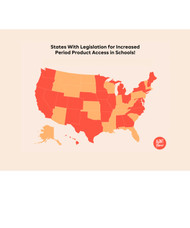What States Require Free Period Products in Schools?
The Push for Menstrual Equity
The push for providing free menstrual products in schools is part of a broader movement toward menstrual equality, addressing the issue of "period poverty" where individuals are unable to afford sanitary products. Advocates argue that access to these products is a right, not a privilege, and is essential for ensuring that students can attend school without interruption due to their menstrual cycle. Many regions and institutions have begun implementing policies to provide menstrual products at no cost in schools, aiming to support educational equity and reduce the stigma associated with menstruation. This movement highlights the importance of treating menstrual care as a basic hygiene necessity, akin to providing toilet paper and soap in school restrooms.
States That Require Free Menstrual Products in Schools
Key legislation and policies around providing free menstrual products in schools have been enacted in several states across the U.S., reflecting a growing recognition of menstrual equity as a priority. These laws are designed to ensure students have access to menstrual products, preventing absenteeism and reducing stigma associated with menstruation. Here are some notable examples:
New York: In 2018, New York passed a law requiring public schools to provide free menstrual products in restrooms for students in grades 6 through 12. This law was one of the earlier pieces of legislation aimed at addressing period poverty in the educational sector.
California: The California Menstrual Equity for All Act of 2021 requires all public schools serving students in grades 6 through 12 to provide free menstrual products in at least one restroom for females and gender-neutral restrooms. This extends to the California State University system and community college districts as well.
Illinois: Illinois requires all school districts to make period products available at no cost to students in each bathroom of every school building that serves students from grades 4 through 12. This legislation also includes provisions for period products in public universities and community colleges.
Virginia: Virginia's legislation, passed in 2020, mandates that public schools serving grades 5 through 12 provide menstrual products in school bathrooms at no charge to students.
Washington: In 2021, Washington state passed a law requiring all public and private schools to provide free menstrual products in school bathrooms by the start of the 2022-2023 school year.
These laws vary by state in terms of the specifics of implementation and funding. The trend is growing, with more states considering similar measures to ensure that lack of access to menstrual products does not hinder students' ability to attend and participate fully in school activities.
For detailed information about specific state laws and updates, you might want to explore resources such as the Alliance for Period Supplies and Aunt Flow.
Impact of Providing Free Period Products in Schools
The impact of providing free period products in schools is significant and multifaceted, affecting both educational outcomes and broader social equity issues. Here are some key impacts observed from such policies:
1. Reduced Absenteeism
One of the most immediate and measurable impacts of providing free menstrual products in schools is a reduction in absenteeism. Students who might otherwise miss school during their periods due to lack of access to sanitary products are more likely to attend classes consistently. This has a direct effect on their academic performance and long-term educational outcomes.
2. Improved Academic Performance
Consistent attendance naturally leads to better academic performance. Being present in school more consistently allows students to participate fully in classroom activities, complete assignments on time, and benefit from interactions with teachers and peers.
3. Enhanced Mental Health and Wellbeing
The stress and anxiety associated with managing menstruation without adequate resources can take a significant toll on students' mental health. Providing free menstrual products can alleviate this stress, leading to improved mental health and overall wellbeing. This support helps in fostering a more inclusive and supportive school environment.
4. Economic Impact
The provision of free menstrual products also has economic benefits. It reduces the financial burden on families who might struggle with the cost of these essential items. This is particularly impactful in lower-income communities, where such costs can be prohibitive.
5. Promotion of Equity and Inclusion
Providing menstrual products for free in schools promotes gender equity and helps ensure that all students, regardless of their background, have equal opportunities to succeed. This policy addresses a basic health need and supports the principle that no student should have their education disrupted by natural biological processes.
6. Reducing Stigma
Openly providing menstrual products in schools helps normalize menstruation, reducing the stigma and embarrassment that can be associated with it. This cultural shift can lead to more open discussions about menstrual health and hygiene, which are important for the overall health education of all students.
Overall, the provision of free menstrual products in schools is seen as a critical step towards ensuring educational equity and supporting the health and dignity of all students. This initiative not only benefits the students directly affected but also contributes to a more equitable society.
Challenges and Considerations
Providing free menstrual products in schools faces several challenges despite its benefits. Funding is a significant concern, as schools often struggle with budget constraints and require consistent financial support to sustain the program. Logistics also pose a problem, with schools needing to ensure products are discreetly and conveniently available. Cultural stigmas around menstruation necessitate educational efforts to normalize menstrual health discussions and reduce associated taboos.
Additionally, maintaining a steady supply and managing inventory require systematic efforts, and there’s a need for diverse product offerings to accommodate different preferences. Monitoring the program's effectiveness through regular feedback and usage data is crucial to make necessary adjustments and improve its impact. Addressing these considerations requires strategic planning, community engagement, and ongoing resource allocation.
The Future of Menstrual Equity in Schools
The future of menstrual equity in schools looks promising as more regions recognize the importance of providing free menstrual products to support student health and education. This movement is gaining momentum through legislative actions and educational policies aimed at normalizing menstruation and ensuring that all students have equal access to learning opportunities.
Trends and Predictions:
Expanded Legislation: More states and countries are likely to pass laws mandating free access to menstrual products in educational institutions. This legislative trend follows growing awareness and advocacy around menstrual equity as a critical aspect of educational equality and public health.
Increased Funding and Support: As the movement grows, there may be increased allocation of funds both from government sources and private donations to support the distribution of menstrual products in schools. This would help address one of the primary challenges—sustaining the supply without burdening school budgets.
Educational Initiatives: There's a growing recognition of the need to combine the provision of menstrual products with educational programs about menstruation and reproductive health. These programs aim to reduce stigma and empower students with knowledge about their bodies.
Inclusive Practices: Efforts are likely to expand beyond just providing products to ensuring that all students, regardless of gender identity, have access to the products they need in a way that respects their privacy and dignity. This includes having products available in all gender restrooms and promoting an inclusive environment.
Technological Integration: Innovations such as smart dispensers that track usage and inventory could become more common, helping schools efficiently manage supplies and ensure that products are always available to those who need them.
Community and Global Movements: As communities see the positive impact of such initiatives, similar models could be adopted in other settings, including workplaces and public facilities, promoting menstrual equity on a broader scale.
These developments are expected to create a more supportive and equitable environment for all students, helping them to participate fully in educational activities without the barriers currently posed by menstrual inequity. The movement towards menstrual equity in schools not only addresses immediate practical needs but also challenges longstanding social stigmas, paving the way for a more inclusive society.
Menstrual Product Dispensers
If you need menstrual product dispensers for your school or facility, explore our selection at Berl’s. Shop a variety of pad and tampon vending machines, including models with no coins needed.

